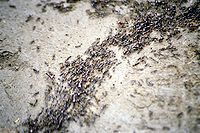
Photo from wikipedia
With the development of mobile Internet technology, the road network in the real world is becoming larger and more complex, and the real-time response to the shortest distance query has… Click to show full abstract
With the development of mobile Internet technology, the road network in the real world is becoming larger and more complex, and the real-time response to the shortest distance query has become a high requirement for many industrial applications. Many existing approaches, such as G-tree or G*-tree, have been proposed to answer such search problems, however, these approaches are not efficient enough in dealing with very large graphs. To this end, we propose a novel index called LG-tree, which partitions the large graph into sub-graphs, and then indexes these subgraphs using a balanced tree. For each leaf node of LG-tree, a Distance Inverted File (DIF) is constructed, and these DIFs preserve all the connectivity information between the border vertices on the original graph. Inspired by the state-of-the-art label methods, we propose a novel hierarchy computing approach for each border vertex of LG-tree. Based on DIF and the hierarchy of border vertices, the border vertex list for each border is established, which is convenient for us to calculate the shortest distance and path between a query vertex
Journal Title: IEEE Transactions on Intelligent Transportation Systems
Year Published: 2022
Link to full text (if available)
Share on Social Media: Sign Up to like & get
recommendations!